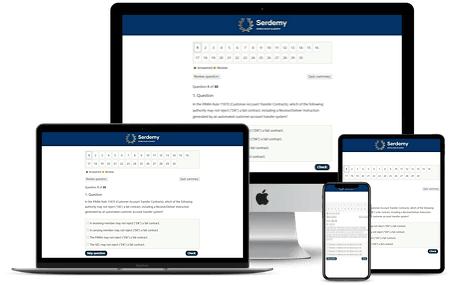Quiz-summary
0 of 30 questions completed
Questions:
- 1
- 2
- 3
- 4
- 5
- 6
- 7
- 8
- 9
- 10
- 11
- 12
- 13
- 14
- 15
- 16
- 17
- 18
- 19
- 20
- 21
- 22
- 23
- 24
- 25
- 26
- 27
- 28
- 29
- 30
Information
Premium Practice Questions
You have already completed the quiz before. Hence you can not start it again.
Quiz is loading...
You must sign in or sign up to start the quiz.
You have to finish following quiz, to start this quiz:
Results
0 of 30 questions answered correctly
Your time:
Time has elapsed
Categories
- Not categorized 0%
- 1
- 2
- 3
- 4
- 5
- 6
- 7
- 8
- 9
- 10
- 11
- 12
- 13
- 14
- 15
- 16
- 17
- 18
- 19
- 20
- 21
- 22
- 23
- 24
- 25
- 26
- 27
- 28
- 29
- 30
- Answered
- Review
-
Question 1 of 30
1. Question
An operations professional at Interstellar Brokerage, while performing a daily reconciliation of the firm’s stock record against the positions held at a depository, discovers a shortfall. The firm’s records show that it should be holding 1,000 shares of a specific security in segregation for a fully-paid customer, but the depository position report confirms only 800 shares are present. There is no pending activity to explain the 200-share difference. According to the requirements of SEC Rule 15c3-3, what is the most critical and immediate action the operations department must ensure is taken?
Correct
The core issue is a deficit in fully-paid customer securities, which directly implicates SEC Rule 15c3-3, the Customer Protection Rule. This rule requires broker-dealers to maintain possession or control over all fully-paid and excess margin securities of their customers. When a reconciliation reveals that the firm cannot account for such securities, it has a deficit. Under SEC Rule 15c3-3, the firm must take prompt steps to resolve this deficit, which typically involves buying in the securities. However, a more immediate and critical requirement relates to the firm’s Reserve Formula calculation. The Reserve Formula is designed to ensure the firm has sufficient cash or qualified securities segregated in a special reserve account to meet its obligations to customers. The formula has credit items (monies owed to customers) and debit items (monies customers owe the firm). When a deficit in customer securities is identified, the market value of those securities as of the computation date must be included as a credit item in the Reserve Formula. This action increases the total credits, thereby increasing the amount of money the firm is required to deposit into its Special Reserve Bank Account for the Exclusive Benefit of Customers. This step financially collateralizes the firm’s obligation for the missing securities, protecting the customers while the firm works to physically resolve the deficit. This is a fundamental control mechanism mandated by the rule to safeguard customer assets. Other actions, such as initiating a buy-in, are also necessary, but the immediate impact on the reserve calculation is a primary regulatory requirement.
Incorrect
The core issue is a deficit in fully-paid customer securities, which directly implicates SEC Rule 15c3-3, the Customer Protection Rule. This rule requires broker-dealers to maintain possession or control over all fully-paid and excess margin securities of their customers. When a reconciliation reveals that the firm cannot account for such securities, it has a deficit. Under SEC Rule 15c3-3, the firm must take prompt steps to resolve this deficit, which typically involves buying in the securities. However, a more immediate and critical requirement relates to the firm’s Reserve Formula calculation. The Reserve Formula is designed to ensure the firm has sufficient cash or qualified securities segregated in a special reserve account to meet its obligations to customers. The formula has credit items (monies owed to customers) and debit items (monies customers owe the firm). When a deficit in customer securities is identified, the market value of those securities as of the computation date must be included as a credit item in the Reserve Formula. This action increases the total credits, thereby increasing the amount of money the firm is required to deposit into its Special Reserve Bank Account for the Exclusive Benefit of Customers. This step financially collateralizes the firm’s obligation for the missing securities, protecting the customers while the firm works to physically resolve the deficit. This is a fundamental control mechanism mandated by the rule to safeguard customer assets. Other actions, such as initiating a buy-in, are also necessary, but the immediate impact on the reserve calculation is a primary regulatory requirement.
-
Question 2 of 30
2. Question
An assessment of a quarterly physical security count at a broker-dealer reveals that a stock certificate for 5,000 shares of a non-DTC eligible security is missing from the firm’s vault. The firm’s stock record correctly indicates the certificate should be in the firm’s possession and control. The direct supervisor of the operations professional conducting the count suggests temporarily altering the stock record to show the position as a “fail to receive” from a contra-broker to resolve the reconciliation break for the day’s processing, with a plan to investigate the matter later. From a regulatory compliance standpoint, what is the most appropriate and immediate course of action for the operations professional?
Correct
The situation describes the discovery of a missing physical security certificate during a required periodic count, which is governed by SEC Rule 17a-13. When a security is discovered to be missing, the firm’s primary obligations are dictated by SEC Rules 17f-1 and 17a-3. The suggestion by the manager to alter the stock record to reflect a “fail to receive” is a direct violation of SEC Rule 17a-3, which requires broker-dealers to make and keep current and accurate books and records. Falsifying a record to conceal a discrepancy is a serious regulatory breach. The correct procedure requires immediate and accurate action. First, the discrepancy must be documented as a “short” position in the firm’s stock record on the day of discovery. Second, a thorough search must be initiated to locate the certificate. Concurrently, under SEC Rule 17f-1, if the security cannot be located after a thorough search, the firm must report the missing security to the Securities Information Center (SIC) and the appropriate transfer agent. This report to the SIC must be made no later than one business day after the discovery. Furthermore, the operations professional has a supervisory and ethical obligation to escalate the situation, especially the manager’s improper directive, to the firm’s compliance department and senior management as per the principles of FINRA Rule 3110 (Supervision) and FINRA Rule 2010 (Standards of Commercial Honor and Principles of Trade).
Incorrect
The situation describes the discovery of a missing physical security certificate during a required periodic count, which is governed by SEC Rule 17a-13. When a security is discovered to be missing, the firm’s primary obligations are dictated by SEC Rules 17f-1 and 17a-3. The suggestion by the manager to alter the stock record to reflect a “fail to receive” is a direct violation of SEC Rule 17a-3, which requires broker-dealers to make and keep current and accurate books and records. Falsifying a record to conceal a discrepancy is a serious regulatory breach. The correct procedure requires immediate and accurate action. First, the discrepancy must be documented as a “short” position in the firm’s stock record on the day of discovery. Second, a thorough search must be initiated to locate the certificate. Concurrently, under SEC Rule 17f-1, if the security cannot be located after a thorough search, the firm must report the missing security to the Securities Information Center (SIC) and the appropriate transfer agent. This report to the SIC must be made no later than one business day after the discovery. Furthermore, the operations professional has a supervisory and ethical obligation to escalate the situation, especially the manager’s improper directive, to the firm’s compliance department and senior management as per the principles of FINRA Rule 3110 (Supervision) and FINRA Rule 2010 (Standards of Commercial Honor and Principles of Trade).
-
Question 3 of 30
3. Question
Amara, a registered representative at Apex Brokerage, has resigned and is moving to a competing firm, Zenith Investments. One of her long-time clients, Mr. Chen, decides to move his account to Zenith to continue working with Amara. The operations department at Apex Brokerage receives a valid ACATS Transfer Initiation Form (TIF) for Mr. Chen’s account. Apex’s management is concerned that Amara may have violated her non-solicitation agreement. From a regulatory standpoint under FINRA rules, what is the required course of action for the Apex operations department?
Correct
The core regulatory principle governing this scenario is FINRA Rule 2140, which prohibits a member firm from interfering with a customer’s request to transfer their account in the context of an employment dispute with a registered representative. The customer’s freedom to choose their broker-dealer is paramount. When a carrying firm receives a valid Transfer Initiation Form (TIF) through the Automated Customer Account Transfer Service (ACATS), it must adhere to the timelines set forth in FINRA Rule 11870. The carrying firm has one business day to validate the transfer instructions. Validation involves checking for matching account details like title, tax ID number, and ensuring there are no existing holds or liens on the account that would prevent a transfer. Once validated, the firm has three business days to complete the transfer of the assets. The employment status of the representative associated with the account is not a valid reason to delay, reject, or otherwise impede the transfer process. Any attempt by the carrying firm to contact the customer to persuade them to remain with the firm, or to place a hold on the account pending resolution of any issues with the departing representative, would be considered a violation. The firm’s recourse for any potential breaches of an employment agreement by the departing representative is a separate matter to be addressed through legal or arbitration channels and cannot be used to obstruct the customer’s right to transfer their assets.
Incorrect
The core regulatory principle governing this scenario is FINRA Rule 2140, which prohibits a member firm from interfering with a customer’s request to transfer their account in the context of an employment dispute with a registered representative. The customer’s freedom to choose their broker-dealer is paramount. When a carrying firm receives a valid Transfer Initiation Form (TIF) through the Automated Customer Account Transfer Service (ACATS), it must adhere to the timelines set forth in FINRA Rule 11870. The carrying firm has one business day to validate the transfer instructions. Validation involves checking for matching account details like title, tax ID number, and ensuring there are no existing holds or liens on the account that would prevent a transfer. Once validated, the firm has three business days to complete the transfer of the assets. The employment status of the representative associated with the account is not a valid reason to delay, reject, or otherwise impede the transfer process. Any attempt by the carrying firm to contact the customer to persuade them to remain with the firm, or to place a hold on the account pending resolution of any issues with the departing representative, would be considered a violation. The firm’s recourse for any potential breaches of an employment agreement by the departing representative is a separate matter to be addressed through legal or arbitration channels and cannot be used to obstruct the customer’s right to transfer their assets.
-
Question 4 of 30
4. Question
An assessment of a clearing firm’s settlement blotter reveals a persistent fail-to-deliver position in Omega Industries common stock, which is not a threshold security. The fail originated from a customer’s fully paid long sale that had a standard settlement date of Wednesday. It is now the following Monday morning, prior to the market open, and the firm’s operations department confirms the position has not yet been delivered. What is the most immediate and mandatory action the firm must take regarding the Omega Industries position under Regulation SHO?
Correct
The core of this scenario involves the mandatory close-out requirements under Regulation SHO, specifically Rule 204, for a fail-to-deliver position resulting from a long sale. Regulation SHO is designed to address failures to deliver and curb potential naked short selling abuses. For a fail-to-deliver position in an equity security that results from a long sale (or any sale where the seller is deemed to own the security), the rule establishes a strict timeline for resolution. The broker-dealer or clearing participant must close out the fail-to-deliver position by purchasing securities of like kind and quantity. This action must be completed no later than the beginning of regular trading hours on the third consecutive settlement day following the standard settlement date (T+2). In this case, the trade settled on Wednesday (T+2). The three consecutive settlement days following this are Thursday, Friday, and the next Monday. Therefore, the mandatory buy-in must be initiated by the beginning of trading on Monday morning. This is often referred to as the T+5 deadline (Trade Date + 2 settlement days + 3 additional days). This requirement is distinct from the close-out rules for short sales or for securities on a firm’s threshold security list, which have different timelines. It is also separate from the requirements of SEC Rule 15c3-3, which would obligate a firm with an aged fail-to-receive (over 30 days) to include it as a credit in its Reserve Formula calculation. The immediate, primary obligation for the firm with the fail-to-deliver from a long sale is the buy-in.
Incorrect
The core of this scenario involves the mandatory close-out requirements under Regulation SHO, specifically Rule 204, for a fail-to-deliver position resulting from a long sale. Regulation SHO is designed to address failures to deliver and curb potential naked short selling abuses. For a fail-to-deliver position in an equity security that results from a long sale (or any sale where the seller is deemed to own the security), the rule establishes a strict timeline for resolution. The broker-dealer or clearing participant must close out the fail-to-deliver position by purchasing securities of like kind and quantity. This action must be completed no later than the beginning of regular trading hours on the third consecutive settlement day following the standard settlement date (T+2). In this case, the trade settled on Wednesday (T+2). The three consecutive settlement days following this are Thursday, Friday, and the next Monday. Therefore, the mandatory buy-in must be initiated by the beginning of trading on Monday morning. This is often referred to as the T+5 deadline (Trade Date + 2 settlement days + 3 additional days). This requirement is distinct from the close-out rules for short sales or for securities on a firm’s threshold security list, which have different timelines. It is also separate from the requirements of SEC Rule 15c3-3, which would obligate a firm with an aged fail-to-receive (over 30 days) to include it as a credit in its Reserve Formula calculation. The immediate, primary obligation for the firm with the fail-to-deliver from a long sale is the buy-in.
-
Question 5 of 30
5. Question
The sequence of events following a trade discrepancy at a clearing firm, Zenith Prime Services, unfolds as follows: On trade date (T), Zenith’s institutional desk believes it has executed and booked a sale of 50,000 shares of a specific equity for its client. On T+1, Zenith receives a “Don’t Know” (DK) notice from the supposed contra-broker, who has no record of the trade. An internal review by Zenith’s operations team reveals that their trader incorrectly booked the trade against the wrong counterparty. The security in question is on the Regulation SHO threshold security list. To mitigate regulatory exposure under SEC Rule 204, what is the most critical immediate action for Zenith’s operations department?
Correct
The initial step is to identify the core issue and the relevant regulations. The receipt of a Don’t Know (DK) notice on settlement date plus one day, or T+1, indicates a mismatch in trade details between the two counterparties. The investigation reveals the cause is an internal booking error. The most critical factor is that the security is on the Regulation SHO threshold list. This designation triggers specific mandatory close-out requirements under SEC Rule 204 to prevent extended fails to deliver. A fail to deliver in a threshold security that is not closed out by the beginning of regular trading hours on the settlement day following the initial settlement date (i.e., T+3 for a standard equity trade) will trigger a mandatory buy-in requirement. Therefore, the firm’s primary and most urgent responsibility is to correct the fundamental error that prevents settlement. The firm must execute a “cancel and correct” procedure. This involves voiding the erroneous trade record booked against the wrong counterparty and re-booking the trade with the correct counterparty’s details. This action is the only way to align the trade records and attempt a proper settlement, thereby potentially avoiding a fail to deliver. Simply initiating a buy-in is premature, as the trade might still be settled if corrected promptly. Placing shares in suspense is an internal accounting measure but does not resolve the settlement obligation. Reporting to a regulator is a secondary step; the immediate priority is to rectify the operational error to comply with settlement and close-out rules.
Incorrect
The initial step is to identify the core issue and the relevant regulations. The receipt of a Don’t Know (DK) notice on settlement date plus one day, or T+1, indicates a mismatch in trade details between the two counterparties. The investigation reveals the cause is an internal booking error. The most critical factor is that the security is on the Regulation SHO threshold list. This designation triggers specific mandatory close-out requirements under SEC Rule 204 to prevent extended fails to deliver. A fail to deliver in a threshold security that is not closed out by the beginning of regular trading hours on the settlement day following the initial settlement date (i.e., T+3 for a standard equity trade) will trigger a mandatory buy-in requirement. Therefore, the firm’s primary and most urgent responsibility is to correct the fundamental error that prevents settlement. The firm must execute a “cancel and correct” procedure. This involves voiding the erroneous trade record booked against the wrong counterparty and re-booking the trade with the correct counterparty’s details. This action is the only way to align the trade records and attempt a proper settlement, thereby potentially avoiding a fail to deliver. Simply initiating a buy-in is premature, as the trade might still be settled if corrected promptly. Placing shares in suspense is an internal accounting measure but does not resolve the settlement obligation. Reporting to a regulator is a secondary step; the immediate priority is to rectify the operational error to comply with settlement and close-out rules.
-
Question 6 of 30
6. Question
An operations professional at a broker-dealer is processing a request from Ms. Chen, an affiliate of a publicly traded, reporting issuer. Ms. Chen wishes to sell a block of her restricted stock, which she has held for 15 months. The shares are held in certificate form and bear a restrictive legend. Ms. Chen has provided all necessary documentation, including a properly filed Form 144. To ensure compliance with SEC Rule 144 and proper handling of the securities, what is the correct operational workflow the firm must follow?
Correct
The correct operational process for selling restricted securities under SEC Rule 144 is a multi-step procedure that must be followed in a specific sequence to ensure compliance and avoid regulatory violations. First, the broker-dealer has a due diligence obligation. It must verify that all conditions of Rule 144 have been met by the seller. For a reporting issuer, this includes a minimum holding period of six months, the availability of current public information about the issuer, adherence to trading volume limitations, and the execution of the sale as a routine brokerage transaction. The seller, if an affiliate, must also have filed Form 144. The broker-dealer typically documents this diligence by obtaining a seller’s representation letter. Critically, the physical or electronic securities themselves bear a restrictive legend, which indicates they are not registered and cannot be freely sold in the public market. These shares are not considered to be in good deliverable form until this legend is removed. Therefore, the next crucial step is for the broker-dealer to submit the legended securities, the seller’s representation letter, and its own broker’s representation letter to the issuer’s designated transfer agent. The transfer agent, acting on the issuer’s behalf, reviews the documentation to confirm the sale complies with Rule 144. Upon satisfaction, the transfer agent will remove the restrictive legend and issue a new, clean certificate or electronically credit the shares to the broker-dealer’s account via a system like DRS or DWAC. Only after the shares are in a clean, freely transferable form can the broker-dealer execute the sale in the public market. Executing the trade before the legend is removed would be improper as the firm does not have good title to the securities it is attempting to sell.
Incorrect
The correct operational process for selling restricted securities under SEC Rule 144 is a multi-step procedure that must be followed in a specific sequence to ensure compliance and avoid regulatory violations. First, the broker-dealer has a due diligence obligation. It must verify that all conditions of Rule 144 have been met by the seller. For a reporting issuer, this includes a minimum holding period of six months, the availability of current public information about the issuer, adherence to trading volume limitations, and the execution of the sale as a routine brokerage transaction. The seller, if an affiliate, must also have filed Form 144. The broker-dealer typically documents this diligence by obtaining a seller’s representation letter. Critically, the physical or electronic securities themselves bear a restrictive legend, which indicates they are not registered and cannot be freely sold in the public market. These shares are not considered to be in good deliverable form until this legend is removed. Therefore, the next crucial step is for the broker-dealer to submit the legended securities, the seller’s representation letter, and its own broker’s representation letter to the issuer’s designated transfer agent. The transfer agent, acting on the issuer’s behalf, reviews the documentation to confirm the sale complies with Rule 144. Upon satisfaction, the transfer agent will remove the restrictive legend and issue a new, clean certificate or electronically credit the shares to the broker-dealer’s account via a system like DRS or DWAC. Only after the shares are in a clean, freely transferable form can the broker-dealer execute the sale in the public market. Executing the trade before the legend is removed would be improper as the firm does not have good title to the securities it is attempting to sell.
-
Question 7 of 30
7. Question
Anya, an associated person of a FINRA member firm, also serves on the board of directors for a non-affiliated, publicly traded corporation. She wishes to sell a block of shares in this corporation that she acquired through a private placement 18 months ago. She presents the physical stock certificate, which bears a restrictive legend, to her firm’s operations department for processing. Assessment of this situation shows that the most critical sequence of actions for the firm’s operations and compliance departments is to:
Correct
The correct procedure requires a multi-departmental, sequential process governed by SEC Rule 144 and internal supervisory controls. First, the firm’s compliance department must conduct a thorough review. This review confirms that the proposed sale by the control person (Anya) adheres to all conditions of Rule 144, including the holding period for restricted securities, volume limitations, manner of sale requirements, and the necessity of filing Form 144 with the SEC. Simultaneously, because the account belongs to an associated person, the transaction is subject to the firm’s heightened written supervisory procedures (WSPs) to monitor for potential conflicts of interest or other violations. Following this internal approval, the next critical step is to address the restrictive legend on the physical certificate. The broker-dealer itself cannot remove the legend. It must obtain an opinion letter from the issuer’s legal counsel, addressed to the transfer agent, affirming that the shares are now eligible for public resale under Rule 144. The operations department then coordinates the submission of this opinion letter, along with the physical certificate and a stock power, to the issuer’s designated transfer agent. Only the transfer agent has the authority to remove the restrictive legend and issue new, unrestricted (clean) shares in either physical or electronic form (e.g., via the Direct Registration System). Once the firm receives confirmation from the transfer agent that clean shares are in its possession or control, the trade can be executed. Executing the sale before the legend is removed and the shares are in good deliverable form would be a violation.
Incorrect
The correct procedure requires a multi-departmental, sequential process governed by SEC Rule 144 and internal supervisory controls. First, the firm’s compliance department must conduct a thorough review. This review confirms that the proposed sale by the control person (Anya) adheres to all conditions of Rule 144, including the holding period for restricted securities, volume limitations, manner of sale requirements, and the necessity of filing Form 144 with the SEC. Simultaneously, because the account belongs to an associated person, the transaction is subject to the firm’s heightened written supervisory procedures (WSPs) to monitor for potential conflicts of interest or other violations. Following this internal approval, the next critical step is to address the restrictive legend on the physical certificate. The broker-dealer itself cannot remove the legend. It must obtain an opinion letter from the issuer’s legal counsel, addressed to the transfer agent, affirming that the shares are now eligible for public resale under Rule 144. The operations department then coordinates the submission of this opinion letter, along with the physical certificate and a stock power, to the issuer’s designated transfer agent. Only the transfer agent has the authority to remove the restrictive legend and issue new, unrestricted (clean) shares in either physical or electronic form (e.g., via the Direct Registration System). Once the firm receives confirmation from the transfer agent that clean shares are in its possession or control, the trade can be executed. Executing the sale before the legend is removed and the shares are in good deliverable form would be a violation.
-
Question 8 of 30
8. Question
The sequence of events for an operations professional at a broker-dealer handling a restricted security deposit requires careful adherence to specific procedures. Consider that Alistair, a director at a small, non-reporting public company, brings a physical stock certificate representing his shares to his broker-dealer. The certificate bears a restrictive legend. Alistair wants to deposit the certificate and subsequently sell the shares. What is the most critical initial action the operations professional must take to process Alistair’s request in compliance with SEC Rule 144?
Correct
The core issue involves the proper handling of a physical stock certificate with a restrictive legend, presented by a client who is an affiliate of the issuer. According to SEC Rule 144, these are considered control securities, and their sale is subject to specific conditions. The restrictive legend on the certificate explicitly prevents its transfer or sale until these conditions are met. The broker-dealer’s operations department cannot simply accept the certificate and make the shares available for sale. The legend must be removed by the issuer’s designated transfer agent. However, the transfer agent will not act without explicit authorization, which comes in the form of a legal opinion letter from the issuer’s counsel. This opinion letter attests that the proposed sale complies with the requirements of Rule 144, such as the holding period (which is one year for non-reporting companies), volume limitations, and manner of sale. Therefore, the first and most critical step for the operations professional is to inform the client that this opinion letter is the necessary prerequisite. The firm cannot proceed with contacting the transfer agent, filing Form 144, or accepting the shares into a deliverable position until the client arranges for the issuer’s counsel to provide this letter to the transfer agent. Attempting to send the certificate to the transfer agent without it will result in rejection. Placing the shares in safekeeping without addressing the legend fails to make them negotiable.
Incorrect
The core issue involves the proper handling of a physical stock certificate with a restrictive legend, presented by a client who is an affiliate of the issuer. According to SEC Rule 144, these are considered control securities, and their sale is subject to specific conditions. The restrictive legend on the certificate explicitly prevents its transfer or sale until these conditions are met. The broker-dealer’s operations department cannot simply accept the certificate and make the shares available for sale. The legend must be removed by the issuer’s designated transfer agent. However, the transfer agent will not act without explicit authorization, which comes in the form of a legal opinion letter from the issuer’s counsel. This opinion letter attests that the proposed sale complies with the requirements of Rule 144, such as the holding period (which is one year for non-reporting companies), volume limitations, and manner of sale. Therefore, the first and most critical step for the operations professional is to inform the client that this opinion letter is the necessary prerequisite. The firm cannot proceed with contacting the transfer agent, filing Form 144, or accepting the shares into a deliverable position until the client arranges for the issuer’s counsel to provide this letter to the transfer agent. Attempting to send the certificate to the transfer agent without it will result in rejection. Placing the shares in safekeeping without addressing the legend fails to make them negotiable.
-
Question 9 of 30
9. Question
An operations professional at a broker-dealer is reviewing a request from a client, Mr. Chen, who is an affiliate of a non-reporting issuer. Mr. Chen wishes to sell a block of restricted stock he acquired 14 months ago. He has provided a properly completed Form 144 to be filed concurrently with the sale. Assessment of the situation requires the operations professional to determine the next essential step to ensure compliance with SEC Rule 144 before the trade can be executed. Which of the following actions is required for the firm to proceed correctly?
Correct
The correct course of action is determined by the specific requirements of SEC Rule 144 for the sale of restricted securities held by an affiliate of a non-reporting issuer. Rule 144 provides a safe harbor from being deemed an underwriter. For securities of a non-reporting company, the holding period is one year, which Mr. Chen has met. However, simply meeting the holding period and filing Form 144 is insufficient. The broker-dealer has a due diligence obligation to ensure all conditions of the rule are met. A critical part of this process involves the removal of the restrictive legend on the stock certificate. The transfer agent will not remove a legend without explicit instruction and assurance from the issuer that the sale is compliant. This assurance comes in the form of a legal opinion letter from the issuer’s counsel. This letter confirms to the broker-dealer and the transfer agent that the issuer has reviewed the proposed transaction and agrees that it complies with Rule 144, thereby authorizing the removal of the legend. Relying solely on the seller’s representations or seeking pre-approval from the transfer agent without the issuer’s legal consent would be a procedural failure and a violation of the firm’s supervisory responsibilities under FINRA Rule 3110. The firm’s Written Supervisory Procedures (WSPs) must detail this process to ensure consistent and compliant handling of such transactions.
Incorrect
The correct course of action is determined by the specific requirements of SEC Rule 144 for the sale of restricted securities held by an affiliate of a non-reporting issuer. Rule 144 provides a safe harbor from being deemed an underwriter. For securities of a non-reporting company, the holding period is one year, which Mr. Chen has met. However, simply meeting the holding period and filing Form 144 is insufficient. The broker-dealer has a due diligence obligation to ensure all conditions of the rule are met. A critical part of this process involves the removal of the restrictive legend on the stock certificate. The transfer agent will not remove a legend without explicit instruction and assurance from the issuer that the sale is compliant. This assurance comes in the form of a legal opinion letter from the issuer’s counsel. This letter confirms to the broker-dealer and the transfer agent that the issuer has reviewed the proposed transaction and agrees that it complies with Rule 144, thereby authorizing the removal of the legend. Relying solely on the seller’s representations or seeking pre-approval from the transfer agent without the issuer’s legal consent would be a procedural failure and a violation of the firm’s supervisory responsibilities under FINRA Rule 3110. The firm’s Written Supervisory Procedures (WSPs) must detail this process to ensure consistent and compliant handling of such transactions.
-
Question 10 of 30
10. Question
To address the challenge of processing a sale of legended securities, consider the following situation. Mr. Chen, a director at a publicly traded company that is current in its SEC filings, presents a physical stock certificate representing restricted shares to his broker-dealer. He has held these shares for over two years and wishes to sell a portion in the open market. An operations professional at the firm, Priya, verifies that the proposed sale quantity is within the volume limits of SEC Rule 144 and that all other substantive conditions of the rule are met. Given this, what is the most critical and immediate operational step Priya’s firm must take to ensure the shares are in good deliverable form for the proposed public sale?
Correct
The core issue revolves around the negotiability of a security certificate bearing a restrictive legend. Under SEC Rule 144, an affiliate selling restricted securities of a reporting issuer must ensure several conditions are met, including a minimum holding period of six months, adherence to volume limitations, and filing a Form 144 with the SEC. The scenario states these substantive conditions are satisfied. However, the physical existence of a restrictive legend on the certificate makes it not good for delivery in a public market sale. The legend serves as a notice to any potential transferee that the securities are unregistered and subject to resale restrictions. Therefore, the critical operational step is to have this legend removed. This process is managed by the issuer’s designated transfer agent. The broker-dealer, acting on behalf of the seller, must formally request the legend removal. This involves submitting the physical certificate to the transfer agent, accompanied by essential documentation. This documentation typically includes a seller’s representation letter (where the seller attests to complying with Rule 144), a broker’s representation letter (confirming the sale will be handled as a standard broker’s transaction), and evidence of the Form 144 filing. The transfer agent will then seek a legal opinion from the issuer’s counsel. Upon receiving confirmation that the sale is compliant, the transfer agent will cancel the legended certificate and issue a new, clean certificate or electronically credit the shares to the broker-dealer’s depository account. Executing the trade before the legend is removed would lead to a settlement fail, as the firm would be unable to deliver clean, negotiable securities to the buyer.
Incorrect
The core issue revolves around the negotiability of a security certificate bearing a restrictive legend. Under SEC Rule 144, an affiliate selling restricted securities of a reporting issuer must ensure several conditions are met, including a minimum holding period of six months, adherence to volume limitations, and filing a Form 144 with the SEC. The scenario states these substantive conditions are satisfied. However, the physical existence of a restrictive legend on the certificate makes it not good for delivery in a public market sale. The legend serves as a notice to any potential transferee that the securities are unregistered and subject to resale restrictions. Therefore, the critical operational step is to have this legend removed. This process is managed by the issuer’s designated transfer agent. The broker-dealer, acting on behalf of the seller, must formally request the legend removal. This involves submitting the physical certificate to the transfer agent, accompanied by essential documentation. This documentation typically includes a seller’s representation letter (where the seller attests to complying with Rule 144), a broker’s representation letter (confirming the sale will be handled as a standard broker’s transaction), and evidence of the Form 144 filing. The transfer agent will then seek a legal opinion from the issuer’s counsel. Upon receiving confirmation that the sale is compliant, the transfer agent will cancel the legended certificate and issue a new, clean certificate or electronically credit the shares to the broker-dealer’s depository account. Executing the trade before the legend is removed would lead to a settlement fail, as the firm would be unable to deliver clean, negotiable securities to the buyer.
-
Question 11 of 30
11. Question
An operations professional at a mid-sized broker-dealer, receives a request from a client, Mr. Ivanov, to sell a block of shares he holds in a private, non-reporting company where he serves as a director. The physical certificates, which he has held for 18 months, bear a prominent restrictive legend. To ensure compliance with SEC Rule 144 and prepare the shares for public sale, which of the following actions represents the most critical and foundational step the operations department must facilitate?
Correct
The solution path involves identifying the key impediment to the sale and the required regulatory and operational steps to resolve it. 1. Identify the security: The shares are restricted (evidenced by the legend) and are also control securities because they are held by an affiliate. 2. Identify the issuer type: The issuer is a non-reporting company. 3. Identify the relevant regulation: SEC Rule 144 provides the safe harbor for the public resale of restricted and control securities. 4. Verify Rule 144 conditions for an affiliate of a non-reporting issuer: – Holding Period: A one-year holding period is required. The client’s 15-month holding period satisfies this. – Current Public Information: The rule requires specific company information to be publicly available. – Volume Limitations, Manner of Sale, and Form 144 Filing: These conditions apply to sales by affiliates. 5. Identify the operational barrier: The physical restrictive legend on the certificate prevents the security from being in “good deliverable form.” It cannot be sold or transferred through clearing systems like DTC until the legend is removed. 6. Determine the process for legend removal: The broker-dealer must work with the issuer and its transfer agent. The transfer agent is the only entity authorized to remove a restrictive legend. The transfer agent will only do so upon receiving sufficient assurance that the sale is compliant with securities laws. 7. Identify the critical document: This assurance is provided via a legal opinion letter from the issuer’s counsel. This letter attests that the conditions of Rule 144 have been met and instructs the transfer agent to remove the legend and issue a clean, unrestricted certificate. Therefore, the most critical procedural step is facilitating the delivery of this legal opinion to the transfer agent to get the legend removed. The sale of restricted or control securities is governed by SEC Rule 144, which provides a safe harbor from registration requirements. When a security certificate bears a restrictive legend, it serves as a physical notice that the shares are not registered and cannot be freely sold in the public market. For an operations professional, the primary task before such a sale can occur is to ensure the shares are put into good deliverable form. This involves the removal of the restrictive legend. The authority to remove this legend rests solely with the issuer’s designated transfer agent. The transfer agent will not act without proper authorization, as doing so prematurely could make them liable for facilitating an illegal distribution of unregistered securities. The standard industry practice requires the seller’s broker-dealer to coordinate with the issuer. The issuer’s counsel must review the proposed sale to ensure it complies with all conditions of Rule 144, including holding periods, volume limitations for affiliates, and public information requirements. Upon a satisfactory review, the counsel will issue a formal opinion letter to the transfer agent. This letter is the key that unlocks the process, authorizing the transfer agent to remove the legend and issue a new, clean certificate or an equivalent electronic position. Without this step, any attempt to sell or deliver the shares will be rejected.
Incorrect
The solution path involves identifying the key impediment to the sale and the required regulatory and operational steps to resolve it. 1. Identify the security: The shares are restricted (evidenced by the legend) and are also control securities because they are held by an affiliate. 2. Identify the issuer type: The issuer is a non-reporting company. 3. Identify the relevant regulation: SEC Rule 144 provides the safe harbor for the public resale of restricted and control securities. 4. Verify Rule 144 conditions for an affiliate of a non-reporting issuer: – Holding Period: A one-year holding period is required. The client’s 15-month holding period satisfies this. – Current Public Information: The rule requires specific company information to be publicly available. – Volume Limitations, Manner of Sale, and Form 144 Filing: These conditions apply to sales by affiliates. 5. Identify the operational barrier: The physical restrictive legend on the certificate prevents the security from being in “good deliverable form.” It cannot be sold or transferred through clearing systems like DTC until the legend is removed. 6. Determine the process for legend removal: The broker-dealer must work with the issuer and its transfer agent. The transfer agent is the only entity authorized to remove a restrictive legend. The transfer agent will only do so upon receiving sufficient assurance that the sale is compliant with securities laws. 7. Identify the critical document: This assurance is provided via a legal opinion letter from the issuer’s counsel. This letter attests that the conditions of Rule 144 have been met and instructs the transfer agent to remove the legend and issue a clean, unrestricted certificate. Therefore, the most critical procedural step is facilitating the delivery of this legal opinion to the transfer agent to get the legend removed. The sale of restricted or control securities is governed by SEC Rule 144, which provides a safe harbor from registration requirements. When a security certificate bears a restrictive legend, it serves as a physical notice that the shares are not registered and cannot be freely sold in the public market. For an operations professional, the primary task before such a sale can occur is to ensure the shares are put into good deliverable form. This involves the removal of the restrictive legend. The authority to remove this legend rests solely with the issuer’s designated transfer agent. The transfer agent will not act without proper authorization, as doing so prematurely could make them liable for facilitating an illegal distribution of unregistered securities. The standard industry practice requires the seller’s broker-dealer to coordinate with the issuer. The issuer’s counsel must review the proposed sale to ensure it complies with all conditions of Rule 144, including holding periods, volume limitations for affiliates, and public information requirements. Upon a satisfactory review, the counsel will issue a formal opinion letter to the transfer agent. This letter is the key that unlocks the process, authorizing the transfer agent to remove the legend and issue a new, clean certificate or an equivalent electronic position. Without this step, any attempt to sell or deliver the shares will be rejected.
-
Question 12 of 30
12. Question
A quarterly physical securities count at a mid-sized broker-dealer reveals a discrepancy. A fully negotiable bearer bond certificate with a face value of $250,000 cannot be located in the firm’s vault. After an initial check of recent transactions and internal transit logs fails to account for the certificate, the Operations Manager determines the security is officially missing. According to SEC Rule 17f-1, what is the required regulatory reporting action for the firm?
Correct
This scenario is governed by SEC Rule 17f-1, which outlines the requirements for reporting missing, lost, counterfeit, or stolen securities. When a securities shortage is discovered as a result of a periodic securities count, such as a quarterly box count, the rule provides a specific timeframe for verification and reporting. The reporting institution has ten business days from the date of the count in which the shortage was first discovered to verify the shortage. Once verified, the firm must report the missing security. The report must be filed with the Securities Information Center (SIC) and the appropriate law enforcement agency. The SIC acts as a central database for lost and stolen securities, which helps prevent their negotiation and transfer. For bearer instruments or situations where criminal activity is suspected, the Federal Bureau of Investigation (FBI) is generally the appropriate law enforcement agency. It is crucial for operations professionals to distinguish this ten-day timeframe for count-related discoveries from the shorter timeframes applicable to other situations, such as a security lost in transit, which typically requires reporting within one or two business days of discovery. This process is a key component of a firm’s custody and control obligations under both SEC and FINRA rules, ensuring the safeguarding of assets and timely regulatory notification of discrepancies.
Incorrect
This scenario is governed by SEC Rule 17f-1, which outlines the requirements for reporting missing, lost, counterfeit, or stolen securities. When a securities shortage is discovered as a result of a periodic securities count, such as a quarterly box count, the rule provides a specific timeframe for verification and reporting. The reporting institution has ten business days from the date of the count in which the shortage was first discovered to verify the shortage. Once verified, the firm must report the missing security. The report must be filed with the Securities Information Center (SIC) and the appropriate law enforcement agency. The SIC acts as a central database for lost and stolen securities, which helps prevent their negotiation and transfer. For bearer instruments or situations where criminal activity is suspected, the Federal Bureau of Investigation (FBI) is generally the appropriate law enforcement agency. It is crucial for operations professionals to distinguish this ten-day timeframe for count-related discoveries from the shorter timeframes applicable to other situations, such as a security lost in transit, which typically requires reporting within one or two business days of discovery. This process is a key component of a firm’s custody and control obligations under both SEC and FINRA rules, ensuring the safeguarding of assets and timely regulatory notification of discrepancies.
-
Question 13 of 30
13. Question
The sequence of operational steps required for a broker-dealer to facilitate the sale of restricted securities held by an affiliate of a non-reporting issuer involves a specific verification process. Consider a scenario where an operations professional at a member firm is handling a request from Mr. Petrov, an affiliate of a non-reporting company, who wishes to sell a block of shares he acquired 15 months ago in a private transaction. The physical stock certificate bears a restrictive legend. To comply with SEC Rule 144 and satisfy the transfer agent, what is the most critical prerequisite the firm must secure before executing the sale?
Correct
The conclusion is reached by applying the specific requirements of SEC Rule 144 to the sale of restricted securities by an affiliate of a non-reporting company. Step 1: Identify the key elements of the scenario. The securities are restricted (acquired privately). The seller is an affiliate (a control person). The issuer is a non-reporting company. Step 2: Apply SEC Rule 144, which provides a safe harbor for selling restricted and control securities. The rule has several conditions that must be met. Step 3: Analyze the holding period requirement. For a non-reporting issuer, the required holding period is one year. The client has held the shares for 15 months, so this condition is met. Step 4: Analyze the current public information requirement. This is a critical condition. For a non-reporting issuer, Rule 144 requires that specific information, as described in Rule 15c2-11, be made publicly available. This is a more stringent and harder-to-verify condition than for a reporting company (which simply needs to be current on its SEC filings). Step 5: Determine the operational process for legend removal. The transfer agent will not remove a restrictive legend without assurance that the sale is exempt from registration. This assurance is typically provided in the form of a formal legal opinion from the issuer’s counsel. This opinion letter attests that all conditions of Rule 144, including the holding period, volume limits, manner of sale, and crucially, the public information requirement, have been satisfied. The broker-dealer has a due diligence obligation to ensure these conditions are met and must obtain this legal opinion before facilitating the sale. Simply meeting the holding period or filing a Form 144 is insufficient without satisfying the other conditions, particularly the public information requirement, which is confirmed by the legal opinion.
Incorrect
The conclusion is reached by applying the specific requirements of SEC Rule 144 to the sale of restricted securities by an affiliate of a non-reporting company. Step 1: Identify the key elements of the scenario. The securities are restricted (acquired privately). The seller is an affiliate (a control person). The issuer is a non-reporting company. Step 2: Apply SEC Rule 144, which provides a safe harbor for selling restricted and control securities. The rule has several conditions that must be met. Step 3: Analyze the holding period requirement. For a non-reporting issuer, the required holding period is one year. The client has held the shares for 15 months, so this condition is met. Step 4: Analyze the current public information requirement. This is a critical condition. For a non-reporting issuer, Rule 144 requires that specific information, as described in Rule 15c2-11, be made publicly available. This is a more stringent and harder-to-verify condition than for a reporting company (which simply needs to be current on its SEC filings). Step 5: Determine the operational process for legend removal. The transfer agent will not remove a restrictive legend without assurance that the sale is exempt from registration. This assurance is typically provided in the form of a formal legal opinion from the issuer’s counsel. This opinion letter attests that all conditions of Rule 144, including the holding period, volume limits, manner of sale, and crucially, the public information requirement, have been satisfied. The broker-dealer has a due diligence obligation to ensure these conditions are met and must obtain this legal opinion before facilitating the sale. Simply meeting the holding period or filing a Form 144 is insufficient without satisfying the other conditions, particularly the public information requirement, which is confirmed by the legal opinion.
-
Question 14 of 30
14. Question
Consider a scenario where Lin Wei, the Chief Financial Officer of a publicly traded, SEC-reporting company, wishes to sell a portion of her company’s stock. She presents her broker-dealer’s operations department with a physical certificate for 50,000 shares, which bears a restrictive legend. She has held these shares for over two years, and her account is flagged under the firm’s WSPs as an “employee-related account.” An assessment of this situation requires the operations professional to follow a precise compliance workflow. Which of the following sequences represents the most appropriate and compliant set of actions for the operations department to take?
Correct
The correct sequence of actions begins with addressing the requirements of SEC Rule 144 for the sale of control and restricted securities. Since the client is an affiliate (a control person) selling restricted stock, she must comply with all conditions of the rule. The first step is to file a Form 144 with the SEC, which must be done concurrently with or prior to placing the order to sell. Next, to make the shares deliverable in good form, the restrictive legend on the physical certificate must be removed. This requires the broker-dealer to obtain a legal opinion letter from the issuer’s counsel, or another qualified attorney, confirming that the proposed sale is exempt from registration and complies with Rule 144. This letter is then provided to the issuer’s transfer agent, who will remove the legend and issue a clean certificate or electronic position. Concurrently, because the account is for an associated person, the firm must adhere to its own Written Supervisory Procedures (WSPs) as required by FINRA rules. This mandates obtaining pre-trade approval from a designated supervisor or principal within the firm. Only after the Form 144 is filed, the legal opinion is secured for legend removal, and internal supervisory approval is granted can the operations professional accept the order for execution. This multi-layered process ensures compliance with both SEC regulations governing the sale of unregistered securities and FINRA rules for supervising the accounts of associated persons.
Incorrect
The correct sequence of actions begins with addressing the requirements of SEC Rule 144 for the sale of control and restricted securities. Since the client is an affiliate (a control person) selling restricted stock, she must comply with all conditions of the rule. The first step is to file a Form 144 with the SEC, which must be done concurrently with or prior to placing the order to sell. Next, to make the shares deliverable in good form, the restrictive legend on the physical certificate must be removed. This requires the broker-dealer to obtain a legal opinion letter from the issuer’s counsel, or another qualified attorney, confirming that the proposed sale is exempt from registration and complies with Rule 144. This letter is then provided to the issuer’s transfer agent, who will remove the legend and issue a clean certificate or electronic position. Concurrently, because the account is for an associated person, the firm must adhere to its own Written Supervisory Procedures (WSPs) as required by FINRA rules. This mandates obtaining pre-trade approval from a designated supervisor or principal within the firm. Only after the Form 144 is filed, the legal opinion is secured for legend removal, and internal supervisory approval is granted can the operations professional accept the order for execution. This multi-layered process ensures compliance with both SEC regulations governing the sale of unregistered securities and FINRA rules for supervising the accounts of associated persons.
-
Question 15 of 30
15. Question
To address the operational and compliance risks presented when a client attempts to deposit a physical stock certificate with a restrictive legend, a firm’s Written Supervisory Procedures (WSPs) must be strictly followed. An operations professional, Kenji, is approached by a client, Ms. Sharma, who wishes to deposit a certificate representing shares of a non-reporting company. The certificate clearly bears a restrictive legend. Ms. Sharma states she has held the shares for over two years and wants to sell them. According to FINRA rules and standard industry practice for risk mitigation, what is the most critical initial action Kenji must take?
Correct
The primary issue involves a restricted security, as indicated by the legend on the certificate, from a non-reporting issuer. According to SEC Rule 144, specific conditions must be met before such securities can be sold in the public market. For a non-reporting company, the holding period for restricted securities is one year. More importantly, there must be current public information available about the issuer, a condition that non-reporting companies typically cannot meet. The presence of a restrictive legend renders the certificate not in “good deliverable form.” From a broker-dealer’s operational and supervisory standpoint, accepting a potentially non-negotiable instrument into custody creates significant regulatory risk. The firm could be deemed to be participating in an illegal distribution of unregistered securities if the shares are sold improperly. Therefore, the firm’s Written Supervisory Procedures (WSPs), as required by FINRA Rule 3110, must dictate a clear protocol for such situations. The initial and most critical step for an operations professional is not to make a unilateral decision or to begin the operational process of deposit. Instead, the matter must be escalated to a qualified supervisor, such as a designated principal, or the compliance/legal department. This senior-level review is necessary to conduct due diligence, which includes verifying that all Rule 144 conditions can be satisfied and obtaining a legal opinion from the issuer’s counsel confirming that the legend can be removed. Only after the firm has formally determined the shares are eligible for sale and the legend can be removed should it consider accepting the certificate. Refusing to accept the certificate pending this comprehensive review is the only prudent course of action to protect the firm from liability.
Incorrect
The primary issue involves a restricted security, as indicated by the legend on the certificate, from a non-reporting issuer. According to SEC Rule 144, specific conditions must be met before such securities can be sold in the public market. For a non-reporting company, the holding period for restricted securities is one year. More importantly, there must be current public information available about the issuer, a condition that non-reporting companies typically cannot meet. The presence of a restrictive legend renders the certificate not in “good deliverable form.” From a broker-dealer’s operational and supervisory standpoint, accepting a potentially non-negotiable instrument into custody creates significant regulatory risk. The firm could be deemed to be participating in an illegal distribution of unregistered securities if the shares are sold improperly. Therefore, the firm’s Written Supervisory Procedures (WSPs), as required by FINRA Rule 3110, must dictate a clear protocol for such situations. The initial and most critical step for an operations professional is not to make a unilateral decision or to begin the operational process of deposit. Instead, the matter must be escalated to a qualified supervisor, such as a designated principal, or the compliance/legal department. This senior-level review is necessary to conduct due diligence, which includes verifying that all Rule 144 conditions can be satisfied and obtaining a legal opinion from the issuer’s counsel confirming that the legend can be removed. Only after the firm has formally determined the shares are eligible for sale and the legend can be removed should it consider accepting the certificate. Refusing to accept the certificate pending this comprehensive review is the only prudent course of action to protect the firm from liability.
-
Question 16 of 30
16. Question
The following case highlights a potential breakdown in a broker-dealer’s internal controls: At Apex Financial Partners, a research analyst named Kenji finalizes a report that includes a significant downgrade of a publicly traded technology company. Before the report is publicly released, a supervisor observes Kenji in a lengthy, undocumented conversation with Maria, a trader on the firm’s proprietary trading desk. Shortly thereafter, the proprietary desk initiates a substantial short position in the same technology company. From a supervisory perspective under FINRA rules, what is the most critical failure demonstrated by Apex Financial Partners in this situation?
Correct
The core issue in this scenario is a failure in the firm’s supervisory control system, specifically concerning the establishment and enforcement of information barriers. FINRA Rule 3110 requires firms to establish and maintain a system to supervise the activities of their associated persons that is reasonably designed to achieve compliance with applicable securities laws and regulations. Furthermore, FINRA Rule 3120 mandates the establishment of supervisory control systems to manage the risks associated with the firm’s business. A critical component of these systems for a multi-service firm is the creation of robust information barriers, often called “Chinese Walls,” to prevent the misuse of material non-public information (MNPI). These barriers are designed to segregate departments that regularly receive MNPI, such as research or investment banking, from departments that execute trades, like a proprietary trading desk. The undocumented conversation between the research analyst and the proprietary trader, followed by a strategically advantageous trade, strongly indicates that the firm’s information barrier was either poorly designed or not enforced. The primary supervisory failure is not the individual trade itself, but the systemic weakness that allowed the communication and potential information leak to occur without detection, documentation, or prevention. An effective supervisory system would have procedures to restrict, monitor, and document any necessary communications between these departments, often requiring a compliance chaperone to be present. The absence of such controls is the fundamental regulatory breakdown.
Incorrect
The core issue in this scenario is a failure in the firm’s supervisory control system, specifically concerning the establishment and enforcement of information barriers. FINRA Rule 3110 requires firms to establish and maintain a system to supervise the activities of their associated persons that is reasonably designed to achieve compliance with applicable securities laws and regulations. Furthermore, FINRA Rule 3120 mandates the establishment of supervisory control systems to manage the risks associated with the firm’s business. A critical component of these systems for a multi-service firm is the creation of robust information barriers, often called “Chinese Walls,” to prevent the misuse of material non-public information (MNPI). These barriers are designed to segregate departments that regularly receive MNPI, such as research or investment banking, from departments that execute trades, like a proprietary trading desk. The undocumented conversation between the research analyst and the proprietary trader, followed by a strategically advantageous trade, strongly indicates that the firm’s information barrier was either poorly designed or not enforced. The primary supervisory failure is not the individual trade itself, but the systemic weakness that allowed the communication and potential information leak to occur without detection, documentation, or prevention. An effective supervisory system would have procedures to restrict, monitor, and document any necessary communications between these departments, often requiring a compliance chaperone to be present. The absence of such controls is the fundamental regulatory breakdown.
-
Question 17 of 30
17. Question
Assessment of Keystone Securities’ response to a significant business disruption, which made its primary operations center inaccessible, reveals a successful operational failover to its secondary site with no interruption in trading. According to FINRA Rule 4370, which of the following actions is a mandatory component of their business continuity plan that must be addressed in this situation?
Correct
No calculation is required for this question. FINRA Rule 4370 requires every member firm to create and maintain a written business continuity plan (BCP) that is reasonably designed to enable the firm to meet its existing obligations to customers and other counter-parties in the event of an emergency or significant business disruption. The rule is principles-based, allowing firms flexibility in designing a plan tailored to their specific business model, but it mandates certain core elements. These elements include data backup and recovery, identification of all mission-critical systems, financial and operational assessments, and alternative communications between the firm and its customers, as well as between the firm and its employees. A critical component of the rule is the customer disclosure requirement. Firms must provide customers, at account opening, with a written summary of their BCP. This summary must also be posted on the firm’s website and mailed to customers upon request. The disclosure must, at a minimum, address how the firm will respond to events of varying scope and provide specific information on how customers can expect to access their funds and securities and communicate with the firm during a disruption. Therefore, when a BCP is activated, a mandatory part of the firm’s responsibility is to execute the plan which inherently includes making sure customers have prompt access to their assets and can use the alternative communication channels that were previously disclosed to them. While other activities like regulatory reporting or internal reviews are important, the direct mandate of Rule 4370 centers on the plan’s existence, maintenance, and the firm’s ability to execute it to protect customer access and communications.
Incorrect
No calculation is required for this question. FINRA Rule 4370 requires every member firm to create and maintain a written business continuity plan (BCP) that is reasonably designed to enable the firm to meet its existing obligations to customers and other counter-parties in the event of an emergency or significant business disruption. The rule is principles-based, allowing firms flexibility in designing a plan tailored to their specific business model, but it mandates certain core elements. These elements include data backup and recovery, identification of all mission-critical systems, financial and operational assessments, and alternative communications between the firm and its customers, as well as between the firm and its employees. A critical component of the rule is the customer disclosure requirement. Firms must provide customers, at account opening, with a written summary of their BCP. This summary must also be posted on the firm’s website and mailed to customers upon request. The disclosure must, at a minimum, address how the firm will respond to events of varying scope and provide specific information on how customers can expect to access their funds and securities and communicate with the firm during a disruption. Therefore, when a BCP is activated, a mandatory part of the firm’s responsibility is to execute the plan which inherently includes making sure customers have prompt access to their assets and can use the alternative communication channels that were previously disclosed to them. While other activities like regulatory reporting or internal reviews are important, the direct mandate of Rule 4370 centers on the plan’s existence, maintenance, and the firm’s ability to execute it to protect customer access and communications.
-
Question 18 of 30
18. Question
An assessment of a discrepancy found during a routine quarterly securities count at a broker-dealer reveals that a physical certificate for 500 shares of a non-DTC eligible security is missing. The firm’s stock record accurately indicates that this fully-paid customer security should be held in safekeeping in the firm’s vault. From a regulatory compliance perspective, what is the most critical and immediate implication of this discovery for the operations department?
Correct
Not applicable. The core of this scenario revolves around the SEC’s Customer Protection Rule, Rule 15c3-3, and its stringent requirements for a broker-dealer to maintain possession or control over all fully-paid and excess margin securities of its customers. A “good control location” is a specific place where securities can be held to satisfy this rule, such as a clearing corporation, a bank as defined in the Securities Exchange Act of 1934, or the broker-dealer’s own physical vault. The stock record is the firm’s official ledger detailing the ownership and location of all securities. FINRA Rule 4522 mandates periodic physical counts of securities in the firm’s possession (a “box count”) to verify that the physical reality aligns with the stock record. When a security that the stock record indicates is in a good control location, like the firm’s vault, is discovered to be physically missing, it immediately creates a deficit in the quantity of securities the firm is required to have in its possession or control under Rule 15c3-3. This is a serious regulatory issue because the firm is failing to safeguard customer assets as required. The firm must take prompt action, generally by the next business day, to eliminate this deficit. This usually involves buying the security in the open market to replace the missing one, thereby restoring its required possession or control position. While reporting the missing certificate to the Securities Information Center (SIC) under Rule 17f-1 is also required, the immediate and most critical implication is the violation of the possession or control requirement under the Customer Protection Rule.
Incorrect
Not applicable. The core of this scenario revolves around the SEC’s Customer Protection Rule, Rule 15c3-3, and its stringent requirements for a broker-dealer to maintain possession or control over all fully-paid and excess margin securities of its customers. A “good control location” is a specific place where securities can be held to satisfy this rule, such as a clearing corporation, a bank as defined in the Securities Exchange Act of 1934, or the broker-dealer’s own physical vault. The stock record is the firm’s official ledger detailing the ownership and location of all securities. FINRA Rule 4522 mandates periodic physical counts of securities in the firm’s possession (a “box count”) to verify that the physical reality aligns with the stock record. When a security that the stock record indicates is in a good control location, like the firm’s vault, is discovered to be physically missing, it immediately creates a deficit in the quantity of securities the firm is required to have in its possession or control under Rule 15c3-3. This is a serious regulatory issue because the firm is failing to safeguard customer assets as required. The firm must take prompt action, generally by the next business day, to eliminate this deficit. This usually involves buying the security in the open market to replace the missing one, thereby restoring its required possession or control position. While reporting the missing certificate to the Securities Information Center (SIC) under Rule 17f-1 is also required, the immediate and most critical implication is the violation of the possession or control requirement under the Customer Protection Rule.
-
Question 19 of 30
19. Question
Kenji, an operations professional at a broker-dealer, is reviewing a request from Mei, an executive vice president of a company that is not subject to SEC reporting requirements. Mei wishes to sell a block of shares she acquired directly from her company in a private placement 10 months ago. The physical certificates she holds bear a prominent restrictive legend. An assessment of this request under SEC Rule 144 requires Kenji to determine the correct course of action. What is the primary reason Kenji must refuse the sale at this time?
Correct
The analysis begins by identifying the three critical facts of the scenario: the client is an affiliate of the issuer, the securities are restricted, and the issuer is a non-reporting company. The sale of such securities is governed by SEC Rule 144. This rule establishes specific conditions that must be met before restricted or control securities can be sold to the public. One of the primary conditions is a minimum holding period. For restricted securities of an issuer that is not subject to the reporting requirements of the Securities Exchange Act of 1934 (a non-reporting issuer), Rule 144 mandates a holding period of at least one year from the time the securities were fully paid for and acquired from the issuer or an affiliate of the issuer. In this case, the client, Mei, acquired the restricted securities only 10 months ago. Since 10 months is less than the required one-year holding period for a non-reporting company, the fundamental condition for a sale under Rule 144 has not been satisfied. Therefore, the operations professional must refuse to process the sale. It is important to distinguish this from the six-month holding period that applies to restricted securities of reporting issuers. Even if the holding period were met, as an affiliate, Mei would still be subject to all other conditions of Rule 144, including volume limitations, manner of sale requirements, and the filing of Form 144. However, the failure to meet the holding period is the initial and definitive reason for the refusal.
Incorrect
The analysis begins by identifying the three critical facts of the scenario: the client is an affiliate of the issuer, the securities are restricted, and the issuer is a non-reporting company. The sale of such securities is governed by SEC Rule 144. This rule establishes specific conditions that must be met before restricted or control securities can be sold to the public. One of the primary conditions is a minimum holding period. For restricted securities of an issuer that is not subject to the reporting requirements of the Securities Exchange Act of 1934 (a non-reporting issuer), Rule 144 mandates a holding period of at least one year from the time the securities were fully paid for and acquired from the issuer or an affiliate of the issuer. In this case, the client, Mei, acquired the restricted securities only 10 months ago. Since 10 months is less than the required one-year holding period for a non-reporting company, the fundamental condition for a sale under Rule 144 has not been satisfied. Therefore, the operations professional must refuse to process the sale. It is important to distinguish this from the six-month holding period that applies to restricted securities of reporting issuers. Even if the holding period were met, as an affiliate, Mei would still be subject to all other conditions of Rule 144, including volume limitations, manner of sale requirements, and the filing of Form 144. However, the failure to meet the holding period is the initial and definitive reason for the refusal.
-
Question 20 of 30
20. Question
Alistair Finch, a director at Innovate Robotics Corp., a fully reporting public company, approaches his broker-dealer to sell a block of shares he acquired through a private placement over a year ago. The physical stock certificate he presents to the operations department has a restrictive legend printed on it. To proceed with the sale in compliance with securities regulations, what is the most critical procedural step the broker-dealer’s operations department must ensure is completed to facilitate the removal of the restrictive legend by the transfer agent?
Correct
When an affiliate or control person of an issuer seeks to sell restricted securities, those securities typically bear a restrictive legend. This legend indicates that the shares are not registered under the Securities Act of 1933 and cannot be sold in a public marketplace unless they are registered or an exemption from registration is available. The most common exemption used is SEC Rule 144. For the broker-dealer’s operations department to facilitate such a sale, a specific process must be followed to have the legend removed. The transfer agent, acting on behalf of the issuer, is responsible for removing the legend from the certificate or book-entry position. However, the transfer agent will not do so without sufficient proof that the transfer is permissible. The cornerstone of this proof is a formal legal opinion, typically provided by the counsel for the issuer. This opinion letter attests that all the conditions of Rule 144 have been met for the proposed sale, such as holding periods, volume limitations, and the availability of current public information about the issuer. The broker-dealer will also typically provide a broker’s representation letter, and the seller will provide a seller’s representation letter, but the legal opinion is the primary document upon which the transfer agent relies to remove the legend and issue a clean, negotiable security. Without this legal opinion, the transfer agent will reject the request, and the securities will remain restricted and non-negotiable.
Incorrect
When an affiliate or control person of an issuer seeks to sell restricted securities, those securities typically bear a restrictive legend. This legend indicates that the shares are not registered under the Securities Act of 1933 and cannot be sold in a public marketplace unless they are registered or an exemption from registration is available. The most common exemption used is SEC Rule 144. For the broker-dealer’s operations department to facilitate such a sale, a specific process must be followed to have the legend removed. The transfer agent, acting on behalf of the issuer, is responsible for removing the legend from the certificate or book-entry position. However, the transfer agent will not do so without sufficient proof that the transfer is permissible. The cornerstone of this proof is a formal legal opinion, typically provided by the counsel for the issuer. This opinion letter attests that all the conditions of Rule 144 have been met for the proposed sale, such as holding periods, volume limitations, and the availability of current public information about the issuer. The broker-dealer will also typically provide a broker’s representation letter, and the seller will provide a seller’s representation letter, but the legal opinion is the primary document upon which the transfer agent relies to remove the legend and issue a clean, negotiable security. Without this legal opinion, the transfer agent will reject the request, and the securities will remain restricted and non-negotiable.
-
Question 21 of 30
21. Question
An assessment of a new institutional client’s deposit request reveals a significant operational hurdle. The client, who is the CEO of a publicly traded, reporting company, wishes to deposit a physical stock certificate representing a substantial block of the company’s shares. The shares were acquired directly from the issuer eight months prior and the certificate bears a prominent restrictive legend. The client has provided clear instructions to deposit the shares and facilitate a sale as soon as possible. What is the most critical and immediate step the operations professional must take to comply with securities regulations before the shares can be made available for sale?
Correct
The core issue involves restricted securities held by an affiliate, which are governed by SEC Rule 144. The physical stock certificate has a restrictive legend, indicating the shares were not acquired in a public offering and are not freely transferable. Before these shares can be sold in the public market, the legend must be removed. The process for legend removal is critical. Simply meeting the Rule 144 holding period, which is six months for an affiliate of a reporting company, is not sufficient on its own to make the shares deliverable. The broker-dealer cannot unilaterally decide the legend is no longer required. The issuer of the securities controls the process. The holder, through their broker-dealer, must request that the issuer authorize the removal. This authorization is typically provided in the form of a legal opinion letter from the issuer’s counsel to the securities’ transfer agent. This letter attests that the proposed sale complies with the provisions of SEC Rule 144 or another applicable exemption. Upon receiving this opinion letter, the transfer agent will remove the legend and re-issue the shares in a clean, negotiable form, either as a new certificate without the legend or by depositing them electronically into the broker-dealer’s account through the Direct Registration System. Only after the shares are re-issued in this “good deliverable form” can the broker-dealer accept them for sale.
Incorrect
The core issue involves restricted securities held by an affiliate, which are governed by SEC Rule 144. The physical stock certificate has a restrictive legend, indicating the shares were not acquired in a public offering and are not freely transferable. Before these shares can be sold in the public market, the legend must be removed. The process for legend removal is critical. Simply meeting the Rule 144 holding period, which is six months for an affiliate of a reporting company, is not sufficient on its own to make the shares deliverable. The broker-dealer cannot unilaterally decide the legend is no longer required. The issuer of the securities controls the process. The holder, through their broker-dealer, must request that the issuer authorize the removal. This authorization is typically provided in the form of a legal opinion letter from the issuer’s counsel to the securities’ transfer agent. This letter attests that the proposed sale complies with the provisions of SEC Rule 144 or another applicable exemption. Upon receiving this opinion letter, the transfer agent will remove the legend and re-issue the shares in a clean, negotiable form, either as a new certificate without the legend or by depositing them electronically into the broker-dealer’s account through the Direct Registration System. Only after the shares are re-issued in this “good deliverable form” can the broker-dealer accept them for sale.
-
Question 22 of 30
22. Question
An operations professional, Kenji, at Apex Brokerage is tasked with processing a deposit of a physical stock certificate from a client, Dr. Alistair Finch. The certificate represents 20,000 shares of XYZ Corp, a company listed on the NYSE and current in its SEC filings. Dr. Finch is an executive vice president of XYZ Corp and acquired these shares eight months ago directly from the company as part of a compensation package. The certificate bears a prominent restrictive legend. Dr. Finch has submitted a request to sell all 20,000 shares immediately. Given this situation, what is the most critical and immediate operational step Kenji’s department must take to facilitate a compliant sale of these shares in the public market?
Correct
The logical process to determine the correct action involves several steps. First, the securities must be properly identified. Because they were acquired directly from the issuer in a non-public transaction, they are defined as “restricted securities” under SEC Rule 144. Second, the status of the seller, Dr. Finch, must be determined. As an executive vice president of the issuing company, he is considered an “affiliate” or “control person.” Therefore, the proposed sale involves both restricted and control stock, and its public resale is governed by all provisions of Rule 144. The conditions of Rule 144 for an affiliate selling restricted securities of a reporting company must be met. These include a minimum holding period of six months, which has been satisfied (8 months). Other conditions include the availability of current public information about the issuer, volume limitations on the amount sold, specific manner of sale requirements, and the filing of a Form 144 with the SEC. However, meeting these conditions does not automatically make the shares sellable. The physical certificate bears a restrictive legend, which indicates the shares are not freely transferable. This legend must be removed by the issuer’s transfer agent before the shares can be considered in “good delivery” form for a public market sale. The transfer agent will not remove the legend based solely on the broker-dealer’s or client’s assertion that Rule 144 has been met. The standard industry practice requires the transfer agent to receive a formal legal opinion letter from the issuer’s counsel. This letter attests that the proposed transaction is in full compliance with the requirements of Rule 144. Therefore, the most critical, prerequisite step for the operations department is to facilitate the acquisition of this legal opinion to initiate the legend removal process.
Incorrect
The logical process to determine the correct action involves several steps. First, the securities must be properly identified. Because they were acquired directly from the issuer in a non-public transaction, they are defined as “restricted securities” under SEC Rule 144. Second, the status of the seller, Dr. Finch, must be determined. As an executive vice president of the issuing company, he is considered an “affiliate” or “control person.” Therefore, the proposed sale involves both restricted and control stock, and its public resale is governed by all provisions of Rule 144. The conditions of Rule 144 for an affiliate selling restricted securities of a reporting company must be met. These include a minimum holding period of six months, which has been satisfied (8 months). Other conditions include the availability of current public information about the issuer, volume limitations on the amount sold, specific manner of sale requirements, and the filing of a Form 144 with the SEC. However, meeting these conditions does not automatically make the shares sellable. The physical certificate bears a restrictive legend, which indicates the shares are not freely transferable. This legend must be removed by the issuer’s transfer agent before the shares can be considered in “good delivery” form for a public market sale. The transfer agent will not remove the legend based solely on the broker-dealer’s or client’s assertion that Rule 144 has been met. The standard industry practice requires the transfer agent to receive a formal legal opinion letter from the issuer’s counsel. This letter attests that the proposed transaction is in full compliance with the requirements of Rule 144. Therefore, the most critical, prerequisite step for the operations department is to facilitate the acquisition of this legal opinion to initiate the legend removal process.
-
Question 23 of 30
23. Question
An operations professional at Apex Clearing Corp. is conducting the weekly review of items for the firm’s reserve formula computation as mandated by SEC Rule 15c3-3. The goal is to accurately segregate customer-related credits and debits to determine the required deposit into the special reserve bank account. Which of the following items identified during the review must be included as a credit balance in the reserve formula calculation?
Correct
The reserve formula, mandated by SEC Rule 15c3-3, is a critical computation for broker-dealers that carry customer accounts. Its purpose is to ensure that the firm has sufficient funds set aside in a special reserve bank account to protect customer assets in the event of the firm’s financial failure. The formula calculates the net amount of money a firm owes to its customers. This is done by summing all customer-related liabilities, known as credits, and subtracting all customer-related assets, known as debits. If the total credits exceed the total debits, the firm must deposit the excess amount into the segregated reserve account. A key credit item in this formula is monies payable against customers’ securities loaned. When a broker-dealer loans out a customer’s fully paid or excess margin securities to another party, typically for short selling, the firm receives cash collateral for the loan. This cash, or the obligation it represents, is money that is ultimately owed to the customer whose securities were loaned. Therefore, it is treated as a liability of the firm to its customer and is included as a credit in the reserve formula. In contrast, items like debit balances in customer margin accounts or fails to deliver represent money owed to the firm, making them debits in the calculation.
Incorrect
The reserve formula, mandated by SEC Rule 15c3-3, is a critical computation for broker-dealers that carry customer accounts. Its purpose is to ensure that the firm has sufficient funds set aside in a special reserve bank account to protect customer assets in the event of the firm’s financial failure. The formula calculates the net amount of money a firm owes to its customers. This is done by summing all customer-related liabilities, known as credits, and subtracting all customer-related assets, known as debits. If the total credits exceed the total debits, the firm must deposit the excess amount into the segregated reserve account. A key credit item in this formula is monies payable against customers’ securities loaned. When a broker-dealer loans out a customer’s fully paid or excess margin securities to another party, typically for short selling, the firm receives cash collateral for the loan. This cash, or the obligation it represents, is money that is ultimately owed to the customer whose securities were loaned. Therefore, it is treated as a liability of the firm to its customer and is included as a credit in the reserve formula. In contrast, items like debit balances in customer margin accounts or fails to deliver represent money owed to the firm, making them debits in the calculation.
-
Question 24 of 30
24. Question
Anika, an operations professional at Apex Brokerage, is reviewing a request from a client, Mr. Chen. Mr. Chen is a director of a privately-held technology startup, making him a corporate insider and an affiliate. He acquired a block of the company’s stock directly from the issuer 10 months ago, and the physical certificates bear a restrictive legend. The startup is not required to file reports with the SEC, classifying it as a non-reporting issuer. Mr. Chen now wishes to sell these shares. Based on SEC Rule 144, what is the correct operational procedure Anika must follow regarding the restrictive legend on Mr. Chen’s stock certificate?
Correct
The determination of the correct procedure hinges on the specific conditions outlined in SEC Rule 144 for the sale of restricted securities. The key factors in this scenario are the client’s status as a control person (an affiliate), the nature of the securities as restricted, the issuer’s status as a non-reporting company, and the length of time the securities have been held. First, identify the applicable holding period. SEC Rule 144 stipulates different holding periods for restricted securities based on whether the issuer is an SEC-reporting company or a non-reporting company. For securities issued by a company that is not subject to the reporting requirements of the Securities Exchange Act of 1934 (a non-reporting issuer), a one-year holding period is required before the securities can be sold. Second, apply this rule to the client’s situation. The client, Mr. Chen, has held the restricted securities for 10 months. Since the issuer is a non-reporting company, the required holding period is one year. The client’s 10-month holding period is insufficient to meet this requirement. Therefore, the conditions for a sale under Rule 144 have not yet been satisfied. The operations professional cannot proceed with facilitating the removal of the restrictive legend from the stock certificate. The firm must inform the client that the shares are not yet eligible for public sale and that the one-year holding period must be completed before a sale can be considered.
Incorrect
The determination of the correct procedure hinges on the specific conditions outlined in SEC Rule 144 for the sale of restricted securities. The key factors in this scenario are the client’s status as a control person (an affiliate), the nature of the securities as restricted, the issuer’s status as a non-reporting company, and the length of time the securities have been held. First, identify the applicable holding period. SEC Rule 144 stipulates different holding periods for restricted securities based on whether the issuer is an SEC-reporting company or a non-reporting company. For securities issued by a company that is not subject to the reporting requirements of the Securities Exchange Act of 1934 (a non-reporting issuer), a one-year holding period is required before the securities can be sold. Second, apply this rule to the client’s situation. The client, Mr. Chen, has held the restricted securities for 10 months. Since the issuer is a non-reporting company, the required holding period is one year. The client’s 10-month holding period is insufficient to meet this requirement. Therefore, the conditions for a sale under Rule 144 have not yet been satisfied. The operations professional cannot proceed with facilitating the removal of the restrictive legend from the stock certificate. The firm must inform the client that the shares are not yet eligible for public sale and that the one-year holding period must be completed before a sale can be considered.
-
Question 25 of 30
25. Question
Kenji, an operations professional at Apex Brokerage, is processing an account opening for Anika, a senior vice president at a non-reporting public company. Anika presents a physical stock certificate for a large block of her company’s stock, which she received as compensation 14 months ago. The certificate bears a restrictive legend. She instructs Kenji to deposit the shares and prepare to sell them. From an operational and compliance standpoint under SEC Rule 144, what is the most critical prerequisite that Apex Brokerage must ensure is completed before the shares can be considered in good deliverable form for a public sale?
Correct
The logical steps to arrive at the correct operational procedure are as follows. First, identify the nature of the securities. The shares are held by a corporate insider (an affiliate) and bear a restrictive legend, classifying them as both “control” and “restricted” securities. Second, recognize that the sale of such securities is governed by SEC Rule 144. Third, understand that for the shares to be sold publicly, they must be in “good deliverable form,” which requires the removal of the restrictive legend from the certificate. Fourth, determine the entity responsible for removing the legend, which is the issuer’s designated transfer agent. Fifth, and most critically, understand what the transfer agent requires before it will remove the legend. The transfer agent will not remove a legend based solely on instructions from the shareholder or the broker-dealer; to protect itself from liability under the Securities Act of 1933, it requires a formal legal opinion from a qualified, independent counsel. This opinion letter must state that the proposed transaction complies with all provisions of Rule 144, including the holding period, volume limitations, and manner of sale requirements. Therefore, the broker-dealer’s most critical operational step is to ensure this legal opinion is procured and provided to the transfer agent. Under SEC Rule 144, securities acquired directly from an issuer in a transaction not involving a public offering are considered “restricted.” Securities held by an affiliate or control person of the issuer (such as a director or senior officer) are considered “control” securities. The securities in this scenario are both. To sell these securities into the public market, specific conditions must be met. A primary physical barrier to their sale is the restrictive legend printed on the certificate, which explicitly states the shares are unregistered and cannot be resold without registration or an applicable exemption. The process of making these shares negotiable involves the removal of this legend by the issuer’s transfer agent. However, the transfer agent will not remove the legend without proper authorization and documentation that indemnifies them from facilitating an illegal, unregistered distribution. The cornerstone of this documentation is a legal opinion letter, often called a Rule 144 opinion letter. This letter is prepared by the issuer’s counsel or another competent attorney, who attests that all conditions of Rule 144 have been satisfied. These conditions include the holding period (a one-year holding period is required for securities of a non-reporting company), current public information requirements, volume limitations on the amount of stock that can be sold, and the manner of sale. For an operations professional, facilitating this process is key. While internal firm reviews and filing a Form 144 are parts of the overall process, neither step enables the transfer agent to act. The legal opinion is the essential key that unlocks the transfer agent’s ability to remove the legend and make the securities deliverable for a public sale.
Incorrect
The logical steps to arrive at the correct operational procedure are as follows. First, identify the nature of the securities. The shares are held by a corporate insider (an affiliate) and bear a restrictive legend, classifying them as both “control” and “restricted” securities. Second, recognize that the sale of such securities is governed by SEC Rule 144. Third, understand that for the shares to be sold publicly, they must be in “good deliverable form,” which requires the removal of the restrictive legend from the certificate. Fourth, determine the entity responsible for removing the legend, which is the issuer’s designated transfer agent. Fifth, and most critically, understand what the transfer agent requires before it will remove the legend. The transfer agent will not remove a legend based solely on instructions from the shareholder or the broker-dealer; to protect itself from liability under the Securities Act of 1933, it requires a formal legal opinion from a qualified, independent counsel. This opinion letter must state that the proposed transaction complies with all provisions of Rule 144, including the holding period, volume limitations, and manner of sale requirements. Therefore, the broker-dealer’s most critical operational step is to ensure this legal opinion is procured and provided to the transfer agent. Under SEC Rule 144, securities acquired directly from an issuer in a transaction not involving a public offering are considered “restricted.” Securities held by an affiliate or control person of the issuer (such as a director or senior officer) are considered “control” securities. The securities in this scenario are both. To sell these securities into the public market, specific conditions must be met. A primary physical barrier to their sale is the restrictive legend printed on the certificate, which explicitly states the shares are unregistered and cannot be resold without registration or an applicable exemption. The process of making these shares negotiable involves the removal of this legend by the issuer’s transfer agent. However, the transfer agent will not remove the legend without proper authorization and documentation that indemnifies them from facilitating an illegal, unregistered distribution. The cornerstone of this documentation is a legal opinion letter, often called a Rule 144 opinion letter. This letter is prepared by the issuer’s counsel or another competent attorney, who attests that all conditions of Rule 144 have been satisfied. These conditions include the holding period (a one-year holding period is required for securities of a non-reporting company), current public information requirements, volume limitations on the amount of stock that can be sold, and the manner of sale. For an operations professional, facilitating this process is key. While internal firm reviews and filing a Form 144 are parts of the overall process, neither step enables the transfer agent to act. The legal opinion is the essential key that unlocks the transfer agent’s ability to remove the legend and make the securities deliverable for a public sale.
-
Question 26 of 30
26. Question
The weekly reserve formula computation at Apex Clearing Services, conducted under SEC Rule 15c3-3, has yielded the following figures for its operations department review: total formula credits of \(\$20,000,000\) and total formula debits of \(\$19,500,000\). A review of the firm’s records shows a current balance of \(\$300,000\) in its Special Reserve Bank Account for the Exclusive Benefit of Customers. Given this computation, what is the immediate regulatory obligation for the firm’s operations department to ensure compliance with the Customer Protection Rule?
Correct
The calculation to determine the required action is based on the SEC Rule 15c3-3 Reserve Formula. The formula computes the net amount a broker-dealer owes its customers and requires that this amount be segregated in a special reserve bank account. First, calculate the required reserve deposit by subtracting total debits from total credits. Total Credits = \(\$20,000,000\) Total Debits = \(\$19,500,000\) Required Reserve Deposit = Total Credits – Total Debits \[\$20,000,000 – \$19,500,000 = \$500,000\] Next, compare the required reserve deposit to the amount currently held in the Special Reserve Bank Account to determine if a deposit or withdrawal is necessary. Required Reserve Deposit = \(\$500,000\) Current Balance in Reserve Account = \(\$300,000\) Since the required deposit is greater than the current balance, the firm has a deficiency. The amount of the deficiency must be deposited into the account. Deficiency = Required Reserve Deposit – Current Balance \[\$500,000 – \$300,000 = \$200,000\] The firm must deposit this \(\$200,000\) deficiency into the Special Reserve Bank Account for the Exclusive Benefit of Customers. SEC Rule 15c3-3, the Customer Protection Rule, is a cornerstone of broker-dealer financial regulation. Its primary purpose is to safeguard customer funds and securities held by a firm. The rule mandates that firms perform a periodic (typically weekly) computation, known as the reserve formula calculation, to determine the total amount of money they owe to customers (credits) versus the money customers owe to them (debits). Credits include items like customer free credit balances and monies received from securities loaned. Debits include items like customer margin loans. If the total credits exceed the total debits, the firm must deposit the excess amount into a segregated bank account. This account is exclusively for the benefit of customers and is protected from the firm’s creditors in the event of insolvency. The deposit to cover any calculated deficiency must be made no later than one hour after the opening of banking business on the second business day following the computation date. This strict requirement ensures that customer funds are promptly protected.
Incorrect
The calculation to determine the required action is based on the SEC Rule 15c3-3 Reserve Formula. The formula computes the net amount a broker-dealer owes its customers and requires that this amount be segregated in a special reserve bank account. First, calculate the required reserve deposit by subtracting total debits from total credits. Total Credits = \(\$20,000,000\) Total Debits = \(\$19,500,000\) Required Reserve Deposit = Total Credits – Total Debits \[\$20,000,000 – \$19,500,000 = \$500,000\] Next, compare the required reserve deposit to the amount currently held in the Special Reserve Bank Account to determine if a deposit or withdrawal is necessary. Required Reserve Deposit = \(\$500,000\) Current Balance in Reserve Account = \(\$300,000\) Since the required deposit is greater than the current balance, the firm has a deficiency. The amount of the deficiency must be deposited into the account. Deficiency = Required Reserve Deposit – Current Balance \[\$500,000 – \$300,000 = \$200,000\] The firm must deposit this \(\$200,000\) deficiency into the Special Reserve Bank Account for the Exclusive Benefit of Customers. SEC Rule 15c3-3, the Customer Protection Rule, is a cornerstone of broker-dealer financial regulation. Its primary purpose is to safeguard customer funds and securities held by a firm. The rule mandates that firms perform a periodic (typically weekly) computation, known as the reserve formula calculation, to determine the total amount of money they owe to customers (credits) versus the money customers owe to them (debits). Credits include items like customer free credit balances and monies received from securities loaned. Debits include items like customer margin loans. If the total credits exceed the total debits, the firm must deposit the excess amount into a segregated bank account. This account is exclusively for the benefit of customers and is protected from the firm’s creditors in the event of insolvency. The deposit to cover any calculated deficiency must be made no later than one hour after the opening of banking business on the second business day following the computation date. This strict requirement ensures that customer funds are promptly protected.
-
Question 27 of 30
27. Question
Implementation of SEC Rule 144 for the sale of restricted securities held by an affiliate of a non-reporting issuer requires the operations department to verify several critical conditions before instructing the transfer agent to remove the restrictive legend. Which of the following sets of conditions represents the most complete and accurate verification process?
Correct
The correct verification process for an affiliate selling restricted securities of a non-reporting issuer under SEC Rule 144 involves several distinct conditions. First, the affiliate must have held the securities for a minimum of one year. This holding period is longer than the six-month period required for securities of an SEC reporting issuer. Second, there must be adequate current public information available about the issuer. For a non-reporting company, this means the information specified in Rule 15c2-11 must be publicly accessible. This is a critical and often stringent requirement. Third, the sale must adhere to volume limitations. The amount of securities sold during any three-month period cannot exceed the greater of 1% of the outstanding shares of the same class or the average weekly trading volume for the four calendar weeks preceding the filing of the notice of sale. Fourth, the sale must be conducted as a standard brokers’ transaction, meaning the firm cannot solicit buy orders. Finally, the affiliate must file a Form 144 with the SEC at or before the time the sell order is placed if the intended sale exceeds 5,000 shares or an aggregate dollar amount of $50,000 in any three-month period. Only after verifying all these conditions can the operations department confidently request the transfer agent to remove the restrictive legend from the certificate.
Incorrect
The correct verification process for an affiliate selling restricted securities of a non-reporting issuer under SEC Rule 144 involves several distinct conditions. First, the affiliate must have held the securities for a minimum of one year. This holding period is longer than the six-month period required for securities of an SEC reporting issuer. Second, there must be adequate current public information available about the issuer. For a non-reporting company, this means the information specified in Rule 15c2-11 must be publicly accessible. This is a critical and often stringent requirement. Third, the sale must adhere to volume limitations. The amount of securities sold during any three-month period cannot exceed the greater of 1% of the outstanding shares of the same class or the average weekly trading volume for the four calendar weeks preceding the filing of the notice of sale. Fourth, the sale must be conducted as a standard brokers’ transaction, meaning the firm cannot solicit buy orders. Finally, the affiliate must file a Form 144 with the SEC at or before the time the sell order is placed if the intended sale exceeds 5,000 shares or an aggregate dollar amount of $50,000 in any three-month period. Only after verifying all these conditions can the operations department confidently request the transfer agent to remove the restrictive legend from the certificate.
-
Question 28 of 30
28. Question
The process of complying with SEC Rule 17a-4 for records retention requires a meticulous application of specific timelines to different document types. An operations manager at a clearing firm, Lin, is reviewing the firm’s archival policy. She identifies the account records for a former client, Mr. Kenji Tanaka, whose individual brokerage account was officially closed on June 15, 2022. All assets were transferred, and the account has held a zero balance since that date. To ensure compliance while managing storage costs, Lin must determine the earliest point in time she can schedule the secure destruction of Mr. Tanaka’s complete account file, which includes his new account form, statements, and all related correspondence. Based on SEC Rule 17a-4, what is the earliest date these specific records can be destroyed?
Correct
Account Closing Date: June 15, 2022 Required Retention Period (SEC Rule 17a-4(c)): 6 years Calculation: \[ \text{June 15, 2022} + 6 \text{ years} = \text{June 15, 2028} \] Earliest Permissible Destruction Date: June 15, 2028 Under the provisions of the Securities Exchange Act of 1934, SEC Rule 17a-4 establishes the minimum time periods that various books and records must be preserved by a broker-dealer. For records pertaining to a customer’s account, such as new account forms, customer agreements, and account statements, the requirement is quite specific. These records must be maintained for a period of not less than six years. A critical aspect of this rule is determining when the six-year retention clock begins. The rule explicitly states that the period starts after the date of the closing of the account. Therefore, the six-year countdown does not begin from the date of the last transaction or the account opening date, but from the official date the account is closed. This ensures that regulators and the firm have access to a complete history of the customer’s relationship for a significant period after it has concluded, which is essential for audits, investigations, and resolving any subsequent disputes. It is also important to note that for the first two years of this six-year period, the records must be maintained in an easily accessible place. This distinction is crucial for operational compliance and proper records management.
Incorrect
Account Closing Date: June 15, 2022 Required Retention Period (SEC Rule 17a-4(c)): 6 years Calculation: \[ \text{June 15, 2022} + 6 \text{ years} = \text{June 15, 2028} \] Earliest Permissible Destruction Date: June 15, 2028 Under the provisions of the Securities Exchange Act of 1934, SEC Rule 17a-4 establishes the minimum time periods that various books and records must be preserved by a broker-dealer. For records pertaining to a customer’s account, such as new account forms, customer agreements, and account statements, the requirement is quite specific. These records must be maintained for a period of not less than six years. A critical aspect of this rule is determining when the six-year retention clock begins. The rule explicitly states that the period starts after the date of the closing of the account. Therefore, the six-year countdown does not begin from the date of the last transaction or the account opening date, but from the official date the account is closed. This ensures that regulators and the firm have access to a complete history of the customer’s relationship for a significant period after it has concluded, which is essential for audits, investigations, and resolving any subsequent disputes. It is also important to note that for the first two years of this six-year period, the records must be maintained in an easily accessible place. This distinction is crucial for operational compliance and proper records management.
-
Question 29 of 30
29. Question
The sequence of events following the discovery of a missing security certificate during a required physical count is critical for regulatory compliance. An operations associate at Apex Clearing Services, during a quarterly count mandated by FINRA Rule 4522, cannot locate a physical certificate for 10,000 shares of a thinly traded stock held in safekeeping. The firm’s stock record confirms its location should be in the vault, and the certificate is known to have a restrictive legend. What is the most appropriate initial set of actions the operations department must take?
Correct
The logical steps to determine the correct procedure are as follows: 1. Initial Verification: The first action upon discovering a potential discrepancy during a securities count is to verify it. This involves recounting the specific securities and thoroughly reviewing all related internal records, such as the stock record, vault logs, and any blotters tracking securities movement, to rule out a clerical or filing error. 2. Regulatory Reporting: Upon confirming the certificate is genuinely missing, SEC Rule 17f-1 mandates a specific reporting requirement. The rule requires the firm to report the missing security to the Securities Information Center (SIC), which is the central database for lost, stolen, counterfeit, and missing securities. For a missing certificate discovered during a count, this report must be filed within one business day of the discovery. 3. Protective Measures: Concurrently with reporting, the firm must take steps to prevent the missing certificate from being improperly negotiated. This is achieved by contacting the issuer’s transfer agent and instructing them to place a “stop transfer” on the specific certificate number. This action effectively freezes the certificate, preventing its transfer to a new owner. 4. Internal Escalation: The matter must be escalated internally to the appropriate supervisors, the compliance department, and the Financial and Operations Principal (FINOP). These steps must be performed promptly to comply with regulations and protect the firm and its client from potential loss. The requirement for a periodic physical count of securities, or “box count,” is established under FINRA Rule 4522, which aims to ensure the firm can account for all securities for which it is responsible. When a count reveals a missing item, the procedures dictated by SEC Rule 17f-1 are triggered. The one-business-day reporting window to the SIC is a critical deadline. Placing a stop transfer with the transfer agent is an essential operational control to mitigate risk associated with the lost certificate, especially one with a restrictive legend which has its own transferability limitations. Failing to take these specific external actions in a timely manner constitutes a significant regulatory breach.
Incorrect
The logical steps to determine the correct procedure are as follows: 1. Initial Verification: The first action upon discovering a potential discrepancy during a securities count is to verify it. This involves recounting the specific securities and thoroughly reviewing all related internal records, such as the stock record, vault logs, and any blotters tracking securities movement, to rule out a clerical or filing error. 2. Regulatory Reporting: Upon confirming the certificate is genuinely missing, SEC Rule 17f-1 mandates a specific reporting requirement. The rule requires the firm to report the missing security to the Securities Information Center (SIC), which is the central database for lost, stolen, counterfeit, and missing securities. For a missing certificate discovered during a count, this report must be filed within one business day of the discovery. 3. Protective Measures: Concurrently with reporting, the firm must take steps to prevent the missing certificate from being improperly negotiated. This is achieved by contacting the issuer’s transfer agent and instructing them to place a “stop transfer” on the specific certificate number. This action effectively freezes the certificate, preventing its transfer to a new owner. 4. Internal Escalation: The matter must be escalated internally to the appropriate supervisors, the compliance department, and the Financial and Operations Principal (FINOP). These steps must be performed promptly to comply with regulations and protect the firm and its client from potential loss. The requirement for a periodic physical count of securities, or “box count,” is established under FINRA Rule 4522, which aims to ensure the firm can account for all securities for which it is responsible. When a count reveals a missing item, the procedures dictated by SEC Rule 17f-1 are triggered. The one-business-day reporting window to the SIC is a critical deadline. Placing a stop transfer with the transfer agent is an essential operational control to mitigate risk associated with the lost certificate, especially one with a restrictive legend which has its own transferability limitations. Failing to take these specific external actions in a timely manner constitutes a significant regulatory breach.
-
Question 30 of 30
30. Question
A client, who is an affiliate of a non-reporting issuer, instructs their broker-dealer, Fiduciary Prime Services, to sell a substantial block of their company’s stock. The client provides an opinion letter from their attorney stating the shares are clear for sale. Fiduciary Prime executes the sale to a counterparty, Sterling Securities. Subsequently, Fiduciary Prime’s operations team verifies that the client has only held the restricted shares for ten months. The transfer agent correctly refuses to remove the restrictive legend and transfer the shares. This results in a fail-to-deliver for Fiduciary Prime. What is the procedurally correct action Fiduciary Prime must take to address this situation under prevailing regulations?
Correct
The core issue revolves around the intersection of SEC Rule 144, the concept of good delivery, and the mandatory close-out requirements under Regulation SHO. For restricted securities issued by a non-reporting company, Rule 144 stipulates a minimum holding period of one year before the securities can be sold in the public market by an affiliate. In this scenario, the affiliate has only held the securities for ten months, which is less than the required one-year period. Therefore, the opinion letter from counsel is invalid, and the restrictive legend on the stock certificate cannot be legally removed. The transfer agent’s refusal to process the transfer is the correct and legally mandated action, as transferring the shares would violate securities law. Because the selling firm cannot deliver the securities it sold, it has created a fail-to-deliver position. The purchasing firm is now owed these securities. Under SEC Regulation SHO, specifically Rule 204, a broker-dealer that has a fail-to-deliver position in an equity security must close out that position by purchasing securities of like kind and quantity. This is a mandatory requirement to protect the integrity of the settlement system and the purchasing party. The selling firm cannot simply cancel the trade unilaterally or wait for the client’s holding period to expire. Its primary and immediate obligation is to its counterparty in the trade. Therefore, the firm must enter the open market, purchase the same number of unrestricted shares of the security, and deliver them to the purchasing firm to cure the fail. Any financial loss incurred in this process, such as a difference in purchase price, is an issue the selling firm must then resolve with its own client who provided the improper instructions and invalid documentation.
Incorrect
The core issue revolves around the intersection of SEC Rule 144, the concept of good delivery, and the mandatory close-out requirements under Regulation SHO. For restricted securities issued by a non-reporting company, Rule 144 stipulates a minimum holding period of one year before the securities can be sold in the public market by an affiliate. In this scenario, the affiliate has only held the securities for ten months, which is less than the required one-year period. Therefore, the opinion letter from counsel is invalid, and the restrictive legend on the stock certificate cannot be legally removed. The transfer agent’s refusal to process the transfer is the correct and legally mandated action, as transferring the shares would violate securities law. Because the selling firm cannot deliver the securities it sold, it has created a fail-to-deliver position. The purchasing firm is now owed these securities. Under SEC Regulation SHO, specifically Rule 204, a broker-dealer that has a fail-to-deliver position in an equity security must close out that position by purchasing securities of like kind and quantity. This is a mandatory requirement to protect the integrity of the settlement system and the purchasing party. The selling firm cannot simply cancel the trade unilaterally or wait for the client’s holding period to expire. Its primary and immediate obligation is to its counterparty in the trade. Therefore, the firm must enter the open market, purchase the same number of unrestricted shares of the security, and deliver them to the purchasing firm to cure the fail. Any financial loss incurred in this process, such as a difference in purchase price, is an issue the selling firm must then resolve with its own client who provided the improper instructions and invalid documentation.













































